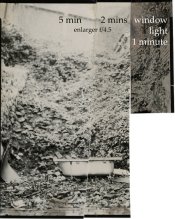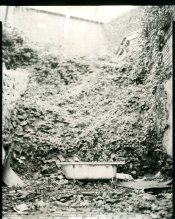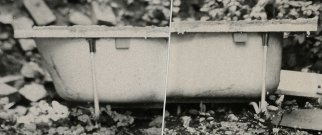I would appreciate that! With the 15% hydrogen peroxide, I use bleach times of 3-5 minutes. I never see it go as "white" (no visible image) as with the dichromate bleach, but perhaps I am not allowing enough time for it to work.
Don
So I decided to ditch writing funding applications and I'm off to the darkroom now, so I should have some more updates later.
But for the moment:
Ilford Multigrade RC paper (8x10) exposed at iso 1.5 (very dense neg)
dev Ilford multigrade 1:9 - 2 minutes (over developed)
12% Peroxide bleach + citric acid (1 teaspoon per 100ml of bleach) - 3 minutes (almost totally white)
re-exposed - window light, afternoon - 5 seconds
dev ilford multigrade (different bath to the first) - 1min 30sec - also in daylight
nicely exposed but no white
Ilford Multigrade RC paper (8x10) exposed at iso 1.5 (very dense neg)
dev Ilford multigrade 1:9 - 1.30 minutes
12% Peroxide bleach + citric acid (1 teaspoon per 100ml of bleach) - 3 minutes (almost totally white)
re-exposed - enlarger with 75watt bulb, f/8 @20 inches - 8 seconds
dev ilford multigrade (different bath to the first) - 1min 30sec
ilford rapid fix - 2 minutes (not worth doing longer)
(all of the above in safelight)
nicely exposed (dual exposure) and good whites
Ilford Multigrade RC paper (8x10) exposed at iso 1.5 (very dense neg)
dev Ilford multigrade 1:9 - 1.30 minute
12% Peroxide bleach + citric acid (1 teaspoon per 100ml of bleach) - 2 minutes (still almost totally white)
re-exposed - enlarger with 75watt bulb, f/8 @20 inches - 8 seconds
dev ilford multigrade (different bath to the first) - 1min 30sec
ilford rapid fix - 2 minutes (not worth doing longer)
(all of the above in safelight)
back to being nice exposure, but no white
Ilford Multigrade RC paper (8x10) exposed at iso 1.5 (very dense neg)
dev Ilford multigrade 1:9 - 1.30 minute
12% Peroxide bleach + citric acid (1 teaspoon per 100ml of bleach) - 3 minutes (still almost totally white)
re-exposed - enlarger with 75watt bulb, f/11 @20 inches - 8 seconds
dev ilford multigrade (different bath to the first) - 1min 30sec
ilford rapid fix - 2 minutes (not worth doing longer)
(all of the above in total dark)
pretty much nothing.
repeated this again with another image of same taken at same time, with re-exposure test strip at 2 second intervals - 2,4,6,8 - f/8
but still nothing.
All of these were done under the assumption that I had initially been overexposing the second exposure the first time I did it in daylight, which is why the second exposure times were getting shorter not longer. Correcting in the wrong direction I guess.
they all correspond to the order I added photos yesterday, and while there isn't a huge amount of variation in the process there, the results seem to be all over the place. There were also a couple of other attempts, with different initial exposure and then processed the same, but that didn't seem to make any difference other than the expected under/overexposed - for example the difference in top and bottom of image 2 I posted yesterday, top is 8 second exposure, bottom is 4 seconds.
Hope this helps.
*just a quick correction, it's actually 2/3 of a teaspoon citric acid per 100ml peroxide












